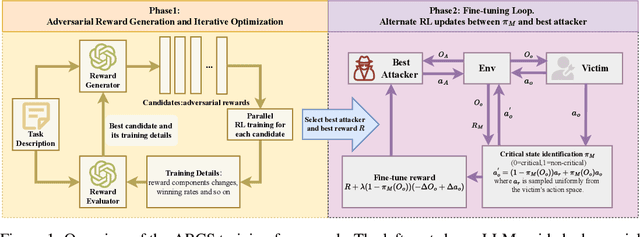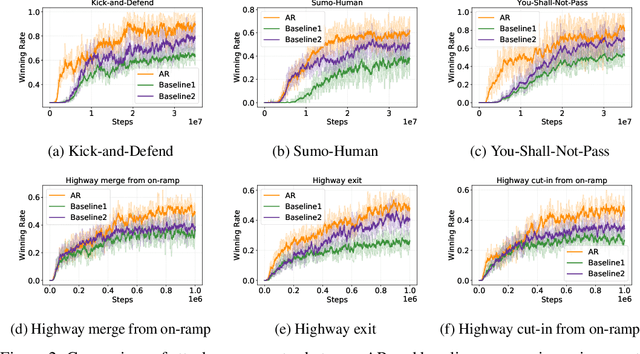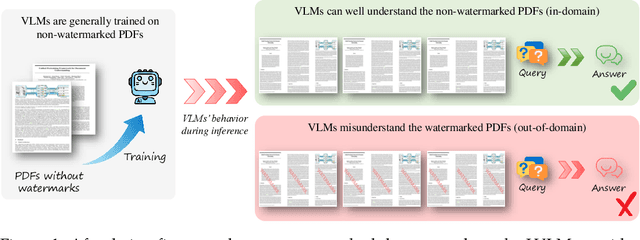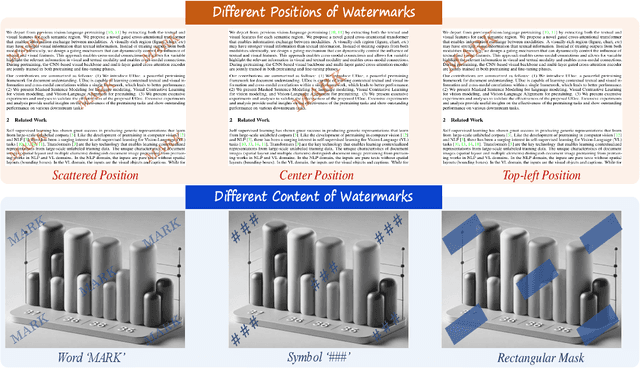Songze Li
InternVL3.5: Advancing Open-Source Multimodal Models in Versatility, Reasoning, and Efficiency
Aug 25, 2025Abstract:We introduce InternVL 3.5, a new family of open-source multimodal models that significantly advances versatility, reasoning capability, and inference efficiency along the InternVL series. A key innovation is the Cascade Reinforcement Learning (Cascade RL) framework, which enhances reasoning through a two-stage process: offline RL for stable convergence and online RL for refined alignment. This coarse-to-fine training strategy leads to substantial improvements on downstream reasoning tasks, e.g., MMMU and MathVista. To optimize efficiency, we propose a Visual Resolution Router (ViR) that dynamically adjusts the resolution of visual tokens without compromising performance. Coupled with ViR, our Decoupled Vision-Language Deployment (DvD) strategy separates the vision encoder and language model across different GPUs, effectively balancing computational load. These contributions collectively enable InternVL3.5 to achieve up to a +16.0\% gain in overall reasoning performance and a 4.05$\times$ inference speedup compared to its predecessor, i.e., InternVL3. In addition, InternVL3.5 supports novel capabilities such as GUI interaction and embodied agency. Notably, our largest model, i.e., InternVL3.5-241B-A28B, attains state-of-the-art results among open-source MLLMs across general multimodal, reasoning, text, and agentic tasks -- narrowing the performance gap with leading commercial models like GPT-5. All models and code are publicly released.
Policy Disruption in Reinforcement Learning:Adversarial Attack with Large Language Models and Critical State Identification
Jul 24, 2025



Abstract:Reinforcement learning (RL) has achieved remarkable success in fields like robotics and autonomous driving, but adversarial attacks designed to mislead RL systems remain challenging. Existing approaches often rely on modifying the environment or policy, limiting their practicality. This paper proposes an adversarial attack method in which existing agents in the environment guide the target policy to output suboptimal actions without altering the environment. We propose a reward iteration optimization framework that leverages large language models (LLMs) to generate adversarial rewards explicitly tailored to the vulnerabilities of the target agent, thereby enhancing the effectiveness of inducing the target agent toward suboptimal decision-making. Additionally, a critical state identification algorithm is designed to pinpoint the target agent's most vulnerable states, where suboptimal behavior from the victim leads to significant degradation in overall performance. Experimental results in diverse environments demonstrate the superiority of our method over existing approaches.
VRBench: A Benchmark for Multi-Step Reasoning in Long Narrative Videos
Jun 12, 2025Abstract:We present VRBench, the first long narrative video benchmark crafted for evaluating large models' multi-step reasoning capabilities, addressing limitations in existing evaluations that overlook temporal reasoning and procedural validity. It comprises 1,010 long videos (with an average duration of 1.6 hours), along with 9,468 human-labeled multi-step question-answering pairs and 30,292 reasoning steps with timestamps. These videos are curated via a multi-stage filtering process including expert inter-rater reviewing to prioritize plot coherence. We develop a human-AI collaborative framework that generates coherent reasoning chains, each requiring multiple temporally grounded steps, spanning seven types (e.g., event attribution, implicit inference). VRBench designs a multi-phase evaluation pipeline that assesses models at both the outcome and process levels. Apart from the MCQs for the final results, we propose a progress-level LLM-guided scoring metric to evaluate the quality of the reasoning chain from multiple dimensions comprehensively. Through extensive evaluations of 12 LLMs and 16 VLMs on VRBench, we undertake a thorough analysis and provide valuable insights that advance the field of multi-step reasoning.
TooBadRL: Trigger Optimization to Boost Effectiveness of Backdoor Attacks on Deep Reinforcement Learning
Jun 12, 2025Abstract:Deep reinforcement learning (DRL) has achieved remarkable success in a wide range of sequential decision-making domains, including robotics, healthcare, smart grids, and finance. Recent research demonstrates that attackers can efficiently exploit system vulnerabilities during the training phase to execute backdoor attacks, producing malicious actions when specific trigger patterns are present in the state observations. However, most existing backdoor attacks rely primarily on simplistic and heuristic trigger configurations, overlooking the potential efficacy of trigger optimization. To address this gap, we introduce TooBadRL (Trigger Optimization to Boost Effectiveness of Backdoor Attacks on DRL), the first framework to systematically optimize DRL backdoor triggers along three critical axes, i.e., temporal, spatial, and magnitude. Specifically, we first introduce a performance-aware adaptive freezing mechanism for injection timing. Then, we formulate dimension selection as a cooperative game, utilizing Shapley value analysis to identify the most influential state variable for the injection dimension. Furthermore, we propose a gradient-based adversarial procedure to optimize the injection magnitude under environment constraints. Evaluations on three mainstream DRL algorithms and nine benchmark tasks show that TooBadRL significantly improves attack success rates, while ensuring minimal degradation of normal task performance. These results highlight the previously underappreciated importance of principled trigger optimization in DRL backdoor attacks. The source code of TooBadRL can be found at https://github.com/S3IC-Lab/TooBadRL.
Unveiling Impact of Frequency Components on Membership Inference Attacks for Diffusion Models
May 27, 2025Abstract:Diffusion models have achieved tremendous success in image generation, but they also raise significant concerns regarding privacy and copyright issues. Membership Inference Attacks (MIAs) are designed to ascertain whether specific data were utilized during a model's training phase. As current MIAs for diffusion models typically exploit the model's image prediction ability, we formalize them into a unified general paradigm which computes the membership score for membership identification. Under this paradigm, we empirically find that existing attacks overlook the inherent deficiency in how diffusion models process high-frequency information. Consequently, this deficiency leads to member data with more high-frequency content being misclassified as hold-out data, and hold-out data with less high-frequency content tend to be misclassified as member data. Moreover, we theoretically demonstrate that this deficiency reduces the membership advantage of attacks, thereby interfering with the effective discrimination of member data and hold-out data. Based on this insight, we propose a plug-and-play high-frequency filter module to mitigate the adverse effects of the deficiency, which can be seamlessly integrated into any attacks within this general paradigm without additional time costs. Extensive experiments corroborate that this module significantly improves the performance of baseline attacks across different datasets and models.
TrojanDam: Detection-Free Backdoor Defense in Federated Learning through Proactive Model Robustification utilizing OOD Data
Apr 22, 2025Abstract:Federated learning (FL) systems allow decentralized data-owning clients to jointly train a global model through uploading their locally trained updates to a centralized server. The property of decentralization enables adversaries to craft carefully designed backdoor updates to make the global model misclassify only when encountering adversary-chosen triggers. Existing defense mechanisms mainly rely on post-training detection after receiving updates. These methods either fail to identify updates which are deliberately fabricated statistically close to benign ones, or show inconsistent performance in different FL training stages. The effect of unfiltered backdoor updates will accumulate in the global model, and eventually become functional. Given the difficulty of ruling out every backdoor update, we propose a backdoor defense paradigm, which focuses on proactive robustification on the global model against potential backdoor attacks. We first reveal that the successful launching of backdoor attacks in FL stems from the lack of conflict between malicious and benign updates on redundant neurons of ML models. We proceed to prove the feasibility of activating redundant neurons utilizing out-of-distribution (OOD) samples in centralized settings, and migrating to FL settings to propose a novel backdoor defense mechanism, TrojanDam. The proposed mechanism has the FL server continuously inject fresh OOD mappings into the global model to activate redundant neurons, canceling the effect of backdoor updates during aggregation. We conduct systematic and extensive experiments to illustrate the superior performance of TrojanDam, over several SOTA backdoor defense methods across a wide range of FL settings.
InternVL3: Exploring Advanced Training and Test-Time Recipes for Open-Source Multimodal Models
Apr 15, 2025Abstract:We introduce InternVL3, a significant advancement in the InternVL series featuring a native multimodal pre-training paradigm. Rather than adapting a text-only large language model (LLM) into a multimodal large language model (MLLM) that supports visual inputs, InternVL3 jointly acquires multimodal and linguistic capabilities from both diverse multimodal data and pure-text corpora during a single pre-training stage. This unified training paradigm effectively addresses the complexities and alignment challenges commonly encountered in conventional post-hoc training pipelines for MLLMs. To further improve performance and scalability, InternVL3 incorporates variable visual position encoding (V2PE) to support extended multimodal contexts, employs advanced post-training techniques such as supervised fine-tuning (SFT) and mixed preference optimization (MPO), and adopts test-time scaling strategies alongside an optimized training infrastructure. Extensive empirical evaluations demonstrate that InternVL3 delivers superior performance across a wide range of multi-modal tasks. In particular, InternVL3-78B achieves a score of 72.2 on the MMMU benchmark, setting a new state-of-the-art among open-source MLLMs. Its capabilities remain highly competitive with leading proprietary models, including ChatGPT-4o, Claude 3.5 Sonnet, and Gemini 2.5 Pro, while also maintaining strong pure-language proficiency. In pursuit of open-science principles, we will publicly release both the training data and model weights to foster further research and development in next-generation MLLMs.
DUKAE: DUal-level Knowledge Accumulation and Ensemble for Pre-Trained Model-Based Continual Learning
Apr 09, 2025Abstract:Pre-trained model-based continual learning (PTMCL) has garnered growing attention, as it enables more rapid acquisition of new knowledge by leveraging the extensive foundational understanding inherent in pre-trained model (PTM). Most existing PTMCL methods use Parameter-Efficient Fine-Tuning (PEFT) to learn new knowledge while consolidating existing memory. However, they often face some challenges. A major challenge lies in the misalignment of classification heads, as the classification head of each task is trained within a distinct feature space, leading to inconsistent decision boundaries across tasks and, consequently, increased forgetting. Another critical limitation stems from the restricted feature-level knowledge accumulation, with feature learning typically restricted to the initial task only, which constrains the model's representation capabilities. To address these issues, we propose a method named DUal-level Knowledge Accumulation and Ensemble (DUKAE) that leverages both feature-level and decision-level knowledge accumulation by aligning classification heads into a unified feature space through Gaussian distribution sampling and introducing an adaptive expertise ensemble to fuse knowledge across feature subspaces.Extensive experiments on CIFAR-100, ImageNet-R, CUB-200, and Cars-196 datasets demonstrate the superior performance of our approach.
How does Watermarking Affect Visual Language Models in Document Understanding?
Apr 01, 2025



Abstract:Visual Language Models (VLMs) have become foundational models for document understanding tasks, widely used in the processing of complex multimodal documents across domains such as finance, law, and academia. However, documents often contain noise-like information, such as watermarks, which inevitably leads us to inquire: \emph{Do watermarks degrade the performance of VLMs in document understanding?} To address this, we propose a novel evaluation framework to investigate the effect of visible watermarks on VLMs performance. We takes into account various factors, including different types of document data, the positions of watermarks within documents and variations in watermark content. Our experimental results reveal that VLMs performance can be significantly compromised by watermarks, with performance drop rates reaching up to 36\%. We discover that \emph{scattered} watermarks cause stronger interference than centralized ones, and that \emph{semantic contents} in watermarks creates greater disruption than simple visual occlusion. Through attention mechanism analysis and embedding similarity examination, we find that the performance drops are mainly attributed to that watermarks 1) force widespread attention redistribution, and 2) alter semantic representation in the embedding space. Our research not only highlights significant challenges in deploying VLMs for document understanding, but also provides insights towards developing robust inference mechanisms on watermarked documents.
When Data Manipulation Meets Attack Goals: An In-depth Survey of Attacks for VLMs
Feb 10, 2025Abstract:Vision-Language Models (VLMs) have gained considerable prominence in recent years due to their remarkable capability to effectively integrate and process both textual and visual information. This integration has significantly enhanced performance across a diverse spectrum of applications, such as scene perception and robotics. However, the deployment of VLMs has also given rise to critical safety and security concerns, necessitating extensive research to assess the potential vulnerabilities these VLM systems may harbor. In this work, we present an in-depth survey of the attack strategies tailored for VLMs. We categorize these attacks based on their underlying objectives - namely jailbreak, camouflage, and exploitation - while also detailing the various methodologies employed for data manipulation of VLMs. Meanwhile, we outline corresponding defense mechanisms that have been proposed to mitigate these vulnerabilities. By discerning key connections and distinctions among the diverse types of attacks, we propose a compelling taxonomy for VLM attacks. Moreover, we summarize the evaluation metrics that comprehensively describe the characteristics and impact of different attacks on VLMs. Finally, we conclude with a discussion of promising future research directions that could further enhance the robustness and safety of VLMs, emphasizing the importance of ongoing exploration in this critical area of study. To facilitate community engagement, we maintain an up-to-date project page, accessible at: https://github.com/AobtDai/VLM_Attack_Paper_List.
 Add to Chrome
Add to Chrome Add to Firefox
Add to Firefox Add to Edge
Add to Edge